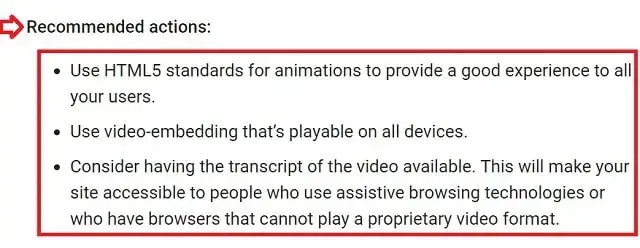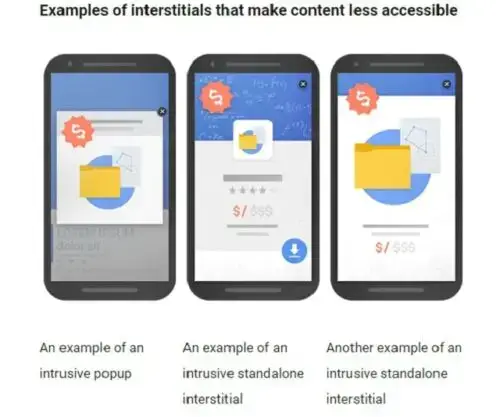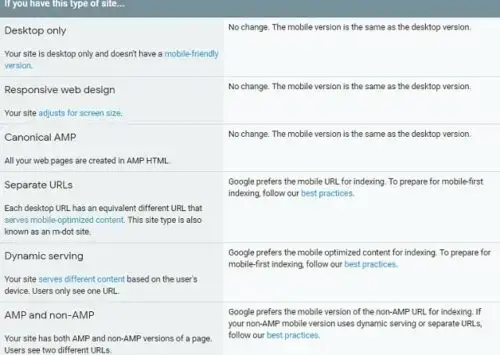In simple terms, mobile SEO involves enhancing your website for use on mobile devices.
By implementing the top mobile SEO strategies, you can boost your site’s search visibility on mobile platforms.
Additionally, Google has introduced mobile-first indexing, prioritizing websites that are optimized for mobile use.
Therefore, optimizing for mobile is an essential step that you should not overlook, regardless of the size or nature of your business.
Here are seven mobile SEO strategies suggested by Google:
- Adopt a responsive web design.
- Improve site speed.
- Use legible typography.
- Improve accessibility.
- Don’t use flash content.
- Avoid using intrusive interstitials.
- Prepare your website for mobile-first indexing.
1. Adopt a responsive web design
Individuals utilize various mobile devices that have different screen dimensions.
With responsive web design, your website can provide an enhanced viewing experience on all mobile devices (tablets/smartphones), regardless of their screen sizes.
Moreover, responsive web design is the design approach that Google endorses.
2. Improve site speed
Pingdom has gathered information about bounce rates related to load times and discovered that the bounce rate increases to very high when a website takes five seconds to load.
Slower websites not only experience higher bounce rates but also suffer from lower rankings. As of July 2018, page speed has been recognized as a ranking criterion for mobile search, as stated in the Google Webmasters blog.
Enhancing site speed is essential for optimizing mobile SEO effectively.
3. Employ clear and readable typography
If the font size on your website is too small, users may need to zoom in to read your content clearly.
Adhere to these best practices to enhance the viewing experience for mobile users:
- Keep each line to no more than eight to ten words (70-80 characters).
- Limit each paragraph to two or three lines.
- Aim for a font size of about 16px.
- Divide long passages of text into smaller segments.
- Ensure proper leading (the space between lines).
4. Enhance accessibility
Google advises:
“Do not place touch elements like buttons and links too close to one another, making it difficult for mobile users to accurately select one without accidentally hitting a nearby element.”
For improved mobile SEO, ensure that:
- Touch buttons are appropriately sized and spaced for mobile users.
- Links stand out with a contrasting color against the text on your web pages.
- Utilize suitable colors and contrasts on web pages to communicate information effectively.
5. Avoid using flash content
Mobile devices cannot access all formats of content.
Media with licenses that restrict access, videos that require the flash player (or other players that are often unsupported on mobile devices), or any other form of content that cannot be played leads to frustration for mobile users and results in a negative mobile experience.
Google is continuously striving to provide users with a smooth search experience.
The search engine giant disapproves of unplayable content.
Google suggests the following measures:

6. Steer clear of intrusive interstitials
Intrusive interstitials either fully or partially obscure webpage content. Interstitials refer to the pop-ups that appear to request your email address or for age verification. In other words, intrusive interstitials compromise the accessibility of your content.
Google has issued a caution regarding this:
“Pages where content is not readily accessible to a user transitioning from mobile search results may not achieve high rankings.”
Here are a few examples of intrusive interstitials you should avoid:
- Utilizing a standalone interstitial that users must close to access the content.
- Implementing a layout in which above-the-fold content resembles an interstitial, with the main content located further down the page.
- Displaying a popup that completely obscures the main content as soon as users land on the page or shortly thereafter.

Avoid using these disruptive interstitials to enhance your website’s mobile SEO.
7. Get your website ready for mobile-first indexing
Mobile-first indexing indicates that Google will prioritize the mobile version of a website when it comes to crawling, indexing, and ranking.
Website owners who have switched to mobile-first indexing can expect notably higher crawl rates from the Smartphone Googlebot, as stated by Google.
Consequently, your mobile SEO efforts will not be fully effective unless you also prepare for mobile-first indexing.
Here’s what is changing with mobile-first indexing:

Adhere to the top guidelines for mobile-first indexing. This will enhance your website’s functionality on mobile platforms.
Therefore, mobile SEO is essential. If your site isn’t optimized for mobile users, you’ll miss out on a considerable amount of traffic.
Implementing these seven mobile SEO best practices will definitely enhance your site’s visibility on mobile devices and assist in generating more leads.
Thanks for visiting. For queries and suggestions, emails are welcome at learnweb@hostingcolumn.com.
Subscribe to Hosting Column for the latest updates and posts.

